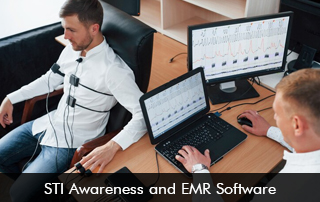EMR software helps effective management of sexually transmitted infections (STIs) easy. With the rising prevalence of STIs globally, the need for comprehensive and efficient solutions to address these infections has never been more critical. Fortunately, advancements in technology, particularly Electronic Medical Record (EMR) software, offer a promising avenue for improving STI awareness, diagnosis, and treatment.
Understanding the STI Epidemic
STIs pose a significant public health challenge worldwide. According to the World Health Organization (WHO), more than one million STIs are acquired every day globally. Common STIs such as chlamydia, gonorrhea, syphilis, and HIV/AIDS can lead to severe health complications if left untreated, including infertility, neurological disorders, and increased risk of HIV transmission. Despite the availability of preventive measures and treatments, STIs persist as a major health concern, fueled by factors such as inadequate access to healthcare, stigma, and insufficient awareness.
The Role of EMR Software in STI Management
EMR software has emerged as a transformative tool in modern healthcare, streamlining clinical workflows, enhancing patient care, and facilitating data-driven decision-making. When it comes to STI management, EMR systems offer several advantages:
Comprehensive Patient Records
EMR software enables healthcare providers to maintain detailed, up-to-date records of patient demographics, medical history, laboratory results, and treatment plans. This comprehensive information allows for better tracking of STI cases, monitoring of treatment outcomes, and identification of high-risk populations.
Integrated Testing and Reporting
EMR systems can streamline the process of STI testing and reporting by integrating laboratory data directly into patient records. Automated alerts and reminders can prompt healthcare providers to follow up on pending test results and initiate appropriate interventions promptly.
EMR Software Decision Support Tools
Many EMR platforms incorporate decision-support tools that offer evidence-based guidelines and recommendations for STI screening, diagnosis, and treatment. These tools help standardize care practices, reduce variability in clinical decision-making, and ensure adherence to best practices.
EMR Software and Population Health Management
EMR software facilitates population health management by enabling healthcare organizations to identify trends, patterns, and disparities in STI prevalence and healthcare utilization. This population-level data can inform targeted interventions, outreach efforts, and resource allocation to communities most affected by STIs.
Telemedicine and Remote Monitoring
With the advent of telemedicine capabilities in EMR systems, healthcare providers can conduct virtual consultations, offer remote counseling, and monitor patients’ progress in STI treatment remotely. This is particularly beneficial for reaching underserved populations, reducing barriers to access, and improving patient engagement.
Addressing Challenges and Barriers
While EMR software holds tremendous potential for enhancing STI awareness and treatment, several challenges and barriers must be addressed to maximize its effectiveness:
Privacy and Confidentiality
Given the sensitive nature of STI-related information, ensuring the privacy and confidentiality of patient data is paramount. Healthcare organizations must implement robust security measures and adhere to legal and ethical standards to protect patient privacy while utilizing EMR systems.
EMR Software Interoperability and Data Sharing
Achieving interoperability between different EMR systems and healthcare institutions is essential for seamless data exchange and coordination of care. Efforts to standardize data formats, protocols, and interfaces can facilitate interoperability and improve the continuity of STI care across healthcare settings.
Health Equity and Access
Access to EMR technology remains uneven, with disparities existing in resource-limited settings and underserved communities. To address health equity concerns, initiatives to expand access to EMR software, provide training and support to healthcare providers, and integrate technology into existing infrastructure are needed.
User Interface Design and Usability
User-friendly interface design and intuitive workflows are crucial for maximizing the usability of EMR software, particularly in busy clinical settings. Engaging end-users, incorporating feedback from clinicians, and prioritizing simplicity and efficiency can enhance user acceptance and adoption of EMR systems for STI management.
EMR Software Promoting STI Awareness and Empowering Patients
In addition to its clinical utility, EMR software can serve as a valuable tool for promoting STI awareness and empowering patients to take control of their sexual health. Features such as patient portals, educational resources, and risk assessment tools can empower individuals to access information, make informed decisions, and engage in proactive health behaviors.
Moreover, EMR platforms can support targeted public health campaigns, outreach initiatives, and community partnerships aimed at raising awareness about STIs, dispelling myths, reducing stigma, and promoting regular testing and preventive measures. By leveraging EMR technology to deliver culturally sensitive, evidence-based information and interventions, healthcare providers can play a pivotal role in combating the STI epidemic and promoting sexual health and well-being.







